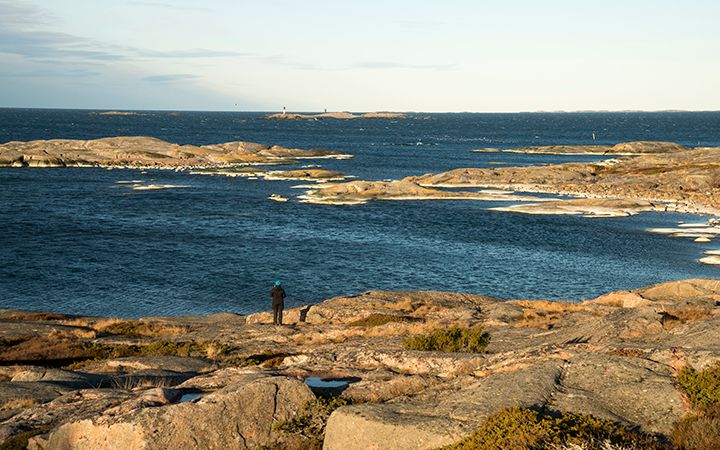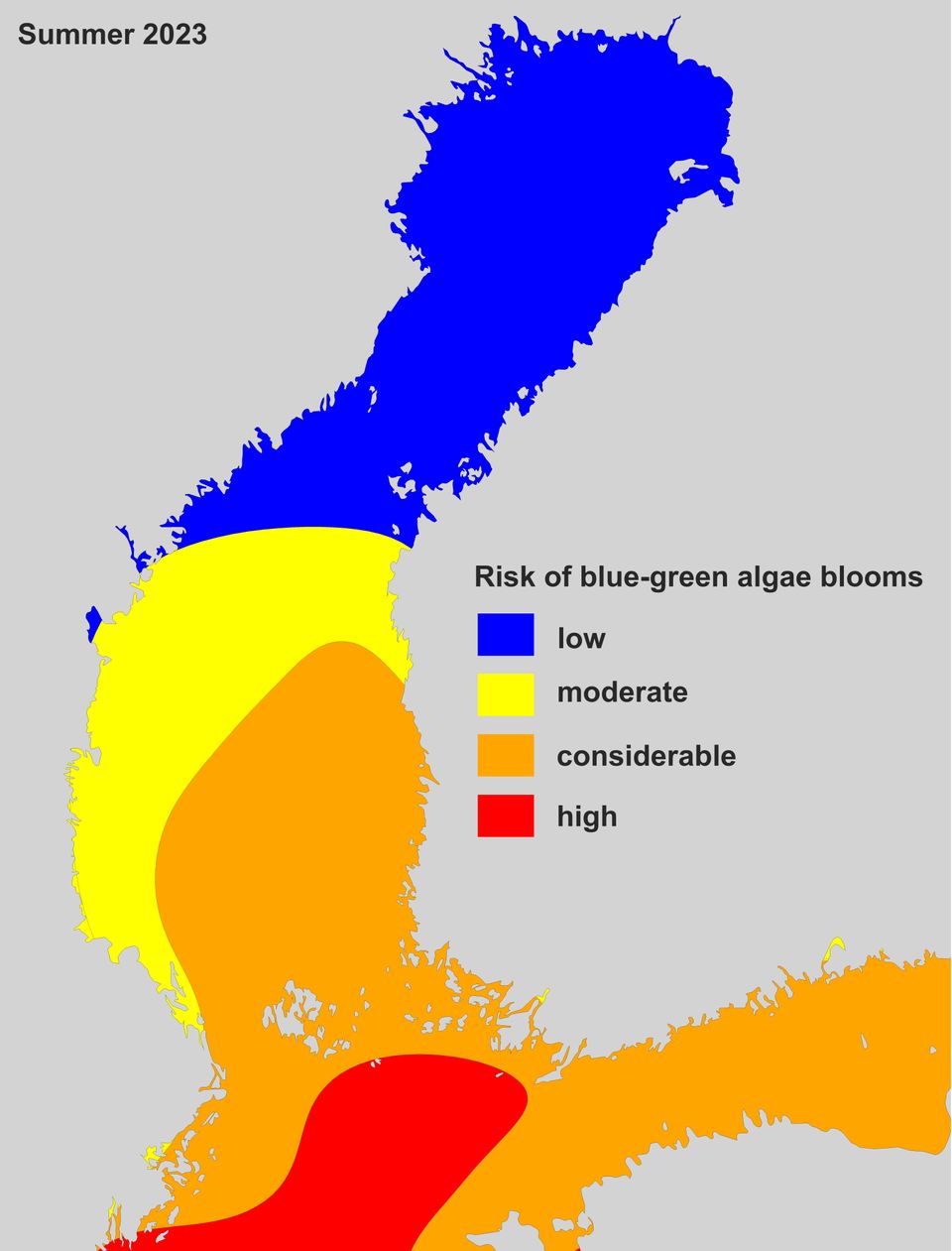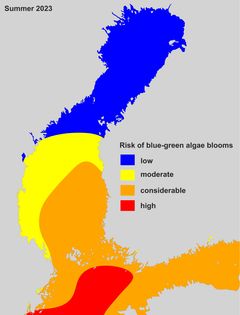Summer algae forecast: Warm and calm weather conditions can lead to powerful blooms of blue-green algae in the Baltic Sea

The risk of extensive blooms of blue-green algae in Finnish sea areas still exists, as the nutrient level in the Baltic Sea continues to favour the appearance of blue-green algae. The risk of the formation of rafts of blue-green algae is considerable this summer in the Gulf of Finland, the northern part of the main basin of the Baltic Sea, the southern part of the Bothnian Sea, and in most of the Archipelago Sea. The risk remains low in the Bothnian Bay. Summertime weather will determine if the risk is realised.
Summertime weather will determine intensity of algae blooms
The risk estimate of blue-green algae blooms is based on the previous winter’s nitrogen and phosphorus levels and on ecosystem modelling. The Finnish Environment Institute and the Swedish Meteorological and Hydrological Institute (SMHI) have conducted extensive measurements on wintertime nutrient levels. In addition to wintertime nutrient levels, springtime nutrient data from coastal monitoring by the Centres for Economic Development, Transport, and the Environment (ELY Centres), @Algaline monitoring by ships, and the spring nutrient data from voyages by the marine research vessel Aranda.

The wintertime nutrient situation provides a regional image of the availability of nitrogen and phosphorus nutrients to the spring blooms of algae. In spring algae blooms, diatoms and dinoflagellates effectively consume nitrogen nutrients, giving the water a reddish-brown colour. However, after the spring bloom, phosphorus nutrients remained widespread in sea areas. Blue-green algae utilise the remaining phosphorus at the surface, which favours the emergence of blooms in the summer when the water gets warmer. A risk forecast based on the phosphorus level is a very good indicator of potential blue-green algae bloom areas. However, weather conditions will be the final deciding factor in the blue-green algae situation.
Blue-green algae thrives in warm water and requires plenty of light to grow. The growth of blue-green algae is slow, and heavy blooms require about two weeks of suitable conditions. The peak of blue-green algae blooms in Finnish marine areas occurs usually at the end of July and early August. The blooms may occur locally late into the autumn, but at that time they are generally not as plentiful as in the summer.
The changes in blue-green algae blooms may be rapid
The formation of masses of algae on the surface at open sea and their drift to the shore depends on wind and water drift conditions. For example, if the wind is blowing toward the shore, surface blooms of blue-green algae can drift into an archipelago area and toward the coast.
The changes in blue-green algae blooms may be rapid. For example, a strong wind will mix a bloom of blue-green algae into the surface water, making the algae more difficult to identify. When the wind eases, blue-green algae may again rise quickly to the surface.
The amount of blue-green algae can vary considerably even in a small area. Water flow conditions and local sources of nutrients may cause blooms of algae along the entire Finnish coast and in the archipelago, especially during calm and warm periods. In addition, wind may cause accumulations of algae in coastal waters and on shores. More detailed information on the movement of algae rafts is available in a weekly bulletin.
Algae notifications getting started
The Finnish Environment Institute issues information on the general blue-green algae situation once a week on Thursdays through the end of August. The summer's first algae report will be issued on the 8th of June 2023, at 13:00.
Observations made on the algae situation by members of the public are collected in the Järvi-meriwiki service.
Keywords
Contacts
Jouni LehtorantaSenior Research ScientistFinnish Environment Insitute
Risk evaluation of algae blooms in Finnish marine areas
Media service at Finnish Environment Institute
The Finnish Environment Institute's Media Service provides information on our research, helps journalists find experts for interviews and provides photos for media use.
Our Communication experts will answer your inquiries on weekdays from 9 am to 4 pm.
Images
Documents
Links
About Suomen ympäristökeskus
It is time to move beyond solving environmental problems one by one, to systemic sustainability transformations. The Finnish Environment Institute (Syke) contributes to building a sustainable society through research, information and services. The Finnish Environment Institute is a research institute with 700 experts and researchers located in Helsinki, Oulu, Jyväskylä and Joensuu.
Subscribe to releases from Suomen ympäristökeskus
Subscribe to all the latest releases from Suomen ympäristökeskus by registering your e-mail address below. You can unsubscribe at any time.
Latest releases from Suomen ympäristökeskus
Viikkokatsaus 24.–28.11.202520.11.2025 11:57:48 EET | Tiedote
Hei! Tässä tiedoksesi meillä Suomen ympäristökeskuksessa ensi viikolla ilmestyviä tiedotteita, uutisia, kampanjoita, blogeja ja uutiskirjeitä. Mukana myös tulevia tapahtumia ja webinaareja. Jakelemme viikkokatsauksen torstaisin STT:n kautta. Koosteet löytyvät myös STT-uutishuoneesta, josta voit tilata kaikki Suomen ympäristökeskuksen tiedotteet.
Proposal for saving the Baltic Sea: 34 actions to strengthen the network of marine protected areas18.11.2025 10:00:00 EET | Press release
Joint press release from Metsähallitus and Finnish Environment Institute Baltic Sea nature is threatened by eutrophication, pollution and climate change. The Roadmap for the development of marine protected area network in Finland until 2030, which was drawn up in cooperation between a number of organisations, presents 34 actions for improving the status of the Baltic Sea, safeguarding the most valuable marine areas and achieving international conservation area targets. Never before has an equally extensive and comprehensive plan for the conservation of marine nature been drawn up in Finland.
Plan för att rädda Östersjön: 34 åtgärdsförslag för att stärka nätverket av marina skyddsområden18.11.2025 10:00:00 EET | Pressmeddelande
Forststyrelsen och Finlands miljöcentral meddelar: Östersjöns natur hotas av eutrofiering, föroreningar och klimatförändringen. Färdplan för utvecklingen av Finlands nätverk av marina skyddsområden fram till 2030, som utarbetats i samarbete mellan flera organisationer, innehåller 34 konkreta åtgärder för att förbättra havets tillstånd, skydda de mest värdefulla havsområdena och uppnå internationella mål för skyddsområdena. En så omfattande och heltäckande plan för skydd av den marina naturen har aldrig tidigare tagits fram.
Suunnitelma Itämeren pelastamiseksi: 34 toimenpide-ehdotusta merensuojelualueverkoston vahvistamiseksi18.11.2025 10:00:00 EET | Tiedote
Suomen ympäristökeskus ja Metsähallitus tiedottavat: Itämeren luontoa uhkaavat rehevöityminen, saastuminen ja ilmastonmuutos. Useiden organisaatioiden yhteistyönä laadittu Suomen merensuojelualueverkoston kehittämisen tiekartta vuoteen 2030 esittää 34 konkreettista toimenpidettä, joilla voidaan parantaa meren tilaa, turvata arvokkaimmat merialueet ja saavuttaa kansainväliset suojelualuetavoitteet. Yhtä laajaa ja kattavaa suunnitelmaa meriluonnon suojelusta ei ole aiemmin tehty.
Viikkokatsaus 17.–21.11.202513.11.2025 12:45:29 EET | Tiedote
Hei! Tässä tiedoksesi meillä Suomen ympäristökeskuksessa ensi viikolla ilmestyviä tiedotteita, uutisia, kampanjoita, blogeja ja uutiskirjeitä. Mukana myös tulevia tapahtumia ja webinaareja. Jakelemme viikkokatsauksen torstaisin STT:n kautta. Koosteet löytyvät myös STT-uutishuoneesta, josta voit tilata kaikki Suomen ympäristökeskuksen tiedotteet.
In our pressroom you can read all our latest releases, find our press contacts, images, documents and other relevant information about us.
Visit our pressroom


